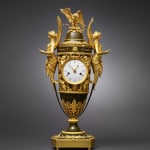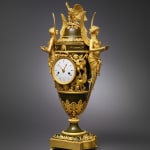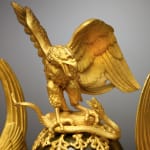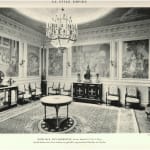
Hotel de M. Pal Marmottan, Avenue Raphaël No. 20, à Paris.
See clock of the left console table.
Charles-Guillaume Hautemanière
Further images
Literature
Literature: Hans Ottomeyer and Peter Pröschel, “Vergoldete Bronzen”, 1986, p. 364, pl. 5.12.6, illustrating an almost identical clock with case by Claude Galle and dial signed Thomissen à Paris, forming a garniture with a pair of accompanying figural vases. Tardy, “Les Plus Belles Pendules Françaises”, 1994, p. 280, illustrating a clock of identical design except that it has turned feet, in the Conservatoire des Arts et Metiers, Paris. Elke Niehüser, “Die Französische Bronzeuhr”, 1997, p. 266, pl. 1344, illustrating an almost identical clock. Pierre Kjellberg, “La Pendule Française du Moyen Age au XXe Siècle”, 1997, p. 326, pl. B, illustrating a clock of almost identical design but with two turning dial rings and a medallion featuring putti in place of the circular dial, also with Victories holding flaming torches and on turned feet, in the Musée François-Duesberg in Mons, Belgium.
An important Empire gilt and patinated bronze Pendule 'aux Victoires' of fourteen day duration by Charles-Guillaume Hautemanière, signed on the white enamel dial Manière à Paris and housed in a magnificent case attributed to Claude Galle. The dial with Roman and Arabic numerals and fine pierced gilt brass hands for the hours and minutes. The movement with anchor escapement anchor escapement, silk thread suspension, striking on the hour and half hour on a single bell, with outside count wheel. The superb case surmounted by a winged eagle personifying Jupiter with a snake symbolising eternity at its feet upon a domed-shaped covered vase, the cover mounted with a fruiting vine spray above a central Egyptian-style mask and pair of snakes, the dial mounted on the front of the vase, decorated above by a wreath and to the upper corners with winged putti and below with griffons and a central Apollo mask, the vase handles formed as outward facing winged monopodia Victories, each holding a tablet, the lower part of the vase with anthemion mounts, on a spreading circular foot upon a stepped rectangular base with rounded ends, mounted on the frieze with hippocampi drinking from a central fountain and on the sides with foliate sprays, on lion paw feet
Paris, date circa 1805-10
Height 63 cm.
The case for this magnificent clock can confidently be attributed to the eminent bronzier Claude Galle (1751-1815) owing to its close comparison with other similar models by him. In addition to those examples in the Württembergischen Landesmuseum in Stuttgart, the Conservatoire des Arts et Metiers and the Musée François-Duesberg, another very similar clock was given to the Emperor Napoleon by the town of Lyon in 1805.
Like his rival Pierre-Philippe Thomire, Claude Galle was one of the foremost bronziers and fondeur-ciseleurs of the late Louis XVI and Empire periods. Born at Villepreux near Versailles he travelled to Paris to begin an apprenticeship under the fondeur, Pierre Foy. In 1784 Galle married Foy's daughter and on his father-in-law's death in 1788 he took over the business which he built up into one the finest of its kind. Galle promptly moved the business to Quai de la Monnaie (renamed Quai de 1'Unité) and from 1805 operated from 60 Rue Vivienne. First listed in the trade registers in 1784 he was received as a maitre-fondeur in 1786 and promptly gained the first of many commissions from the Garde-Meuble de la Couronne under Jean Hauré from 1786-88. He is known to have collaborated with Pierre-Philippe Thomire, amongst others, and was responsible for the majority of bronzes d'ameublement supplied during the Empire to Château de Fontainebleau. Other Imperial commissions included the supply of numerous light fittings, figural clock cases, vases and other fine bronze furnishings for the palaces at Saint-Cloud, the Trianons, Tuileries, Compiègne, Rambouillet and a number of the Italian palaces including Monte Cavallo, Rome and Stupinigi near Turin. Yet despite numerous important commissions Galle, like Thomire was often in debt; in Galle's case this was partly on account of his lavish life style and also since many of his clients, such as Prince Joseph Napoleon, failed to pay him. After his death Galle's business was reopened and prospered under his son, Gérard-Jean Galle (1788-1846). His work can be found among the world's finest collections including those mentioned above as well as the Musée National de Château de Malmaison, the Musée Marmottan in Paris, the Museo de Reloges at Jerez de la Frontera, the Residenz Munich and the Victoria and Albert Museum in London.
The movement was made by the esteemed Parisian horloger Charles-Guillaume Hautemanière, known as Manière (d. after 1812), who is known to have used cases by Claude Galle as well as other leading bronziers such as Jean-Baptiste Osmond, Pierre-Philippe Thomire, François Rémond, Edme Roy and François Vion. Manière was the son of a Parisian maître-horloger, Jean-Pierre (d. after 1789). At the time he was received as a maître in 1778, Manière was established at rue du Four-Saint-Honoré; by 1781 he had moved to rue des Prouvaires and by 1789 to rue Mercier. He later moved to rue Christine, 1806 and four years later was recorded at rue Bertin-Poirée. During the late eighteenth century he worked extensively for the marchand-mercier Dominique Daguerre as well as the Darnaults. Daguerre's appreciation of Manière's work is reflected in the fact that out of eight clocks listed in his probate inventory of 1796, six were by Manière; records also show that at the time of his death Daguerre still owed Manière 180 livres. Manière's clocks were regarded as much as for their mechanical excellence as for their aesthetic value of which examples can be found in many public collections including the Châteaux de Fontainebleau and Versailles, in Paris at the Musée des Arts Décoratifs and Musée Nissim-de-Camondo as well as the Patrimonio Nacional in Madrid. In addition the Museum of Decorative Arts in Prague, the Palazzo del Quirinale in Rome and Palazzo Reale in Turin, as well as the Hermitage Museum, Saint Petersburg and Woburn Abbey, Woodstock, Oxfordshire also own examples from his outstanding oeuvre.








